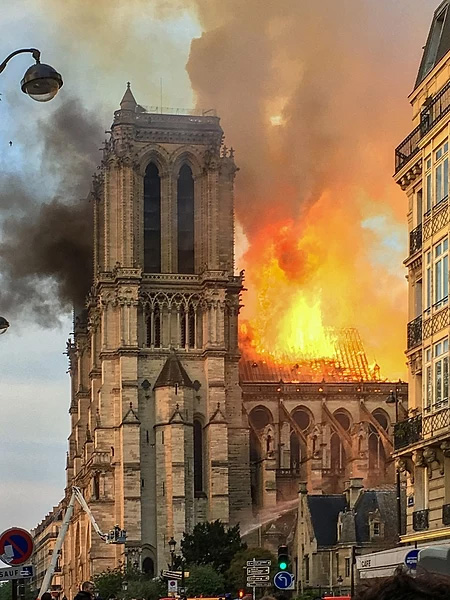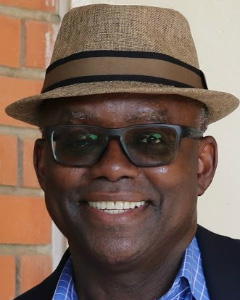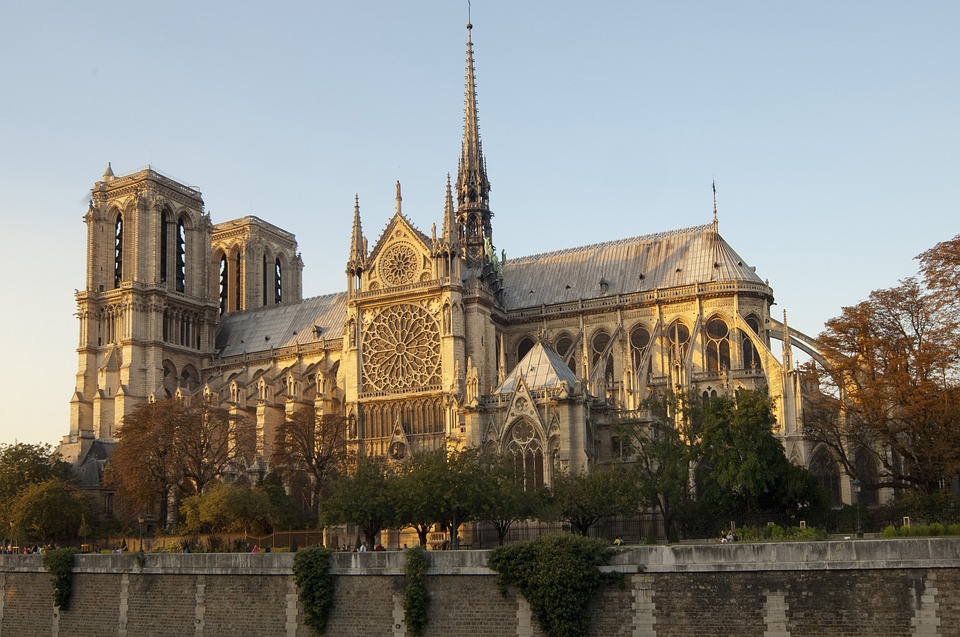The resourcefulness of engineers is often at its best when things are at their worst. Shock turned to grief, then to unity, and then to the promise of regrowth as Parisians—and the rest of the human planet—followed news of the fire that eviscerated Notre Dame Cathedral this week, consuming much of the wooden interior, the 19th century spire, most of the roof, and the lattice of centuries-old wooden beams supporting it.
Now, the world wants to know how project engineers might go about restoring the cathedral.

A massive blaze on April 15 damaged large parts of Notre Dame Cathedral.
In an almost uncanny development, Dr. Ahmad Hamid, professor in the Drexel College of Engineering Department of Civil, Architectural and Environmental Engineering (CAEE), co-authored the forthcoming Assessment and Retrofit of Masonry Structures, which is likely to be one of the foremost books on stonework in the world following its publication this spring by The Masonry Society. The book will have considerable relevance for the Notre Dame project as engineers seek to stabilize, evaluate, and retrofit the historic cathedral’s masonry. In fact, Hamid said he plans to appeal to the Society to sponsor a group of US experts to offer guidance on the restoration.
“The way I see it,” said Hamid, “we’ve got to provide service as much as we can. We will attempt to lend our expertise and have it available to them, and hopefully that will help.
That’s part of our mission.”
For a take on how a vast host of engineers, architects, stone masons, fire safety experts, artisans and—inevitably—politicians will likely conduct the restoration project, three CoE professors sat down for a Q&A. In addition to Hamid, they are: Dr. Charles W. Cook, clinical professor in the Department of Construction, Engineering and Project Management and Systems Engineering; and Dr. Abieyuva Aghayere, professor, CAEE.
What is your perspective on the damage to the Cathedral?
Hamid: The whole thing could have gone down and left just the stone walls. Fortunately, the stone masonry bell towers and the exterior stone walls do not appear to have suffered significant damage. This is because the thick masonry walls have a high fire resistance rating.

Dr. Ahmad Hamid
My understanding today is that at least a portion of the stone structure remains, but I don’t know how effective that portion is. In a structure like this, the roof is not just responsible for keeping the elements away or providing support for snow loads or wind loads: the roof also provides what we call a diaphragm—that is, stability to the vertical walls on the side of the building. Without that, the tops of the walls are not supported, so they act as cantilevered elements with overstressing at the base. This situation makes the walls highly vulnerable to damage in the form of cracking and excessive deflection.
Cook: From an engineering perspective, this fire appears to be an incredible disaster. When constructors demolish a building, the best method is usually in the reverse order in which the building was constructed. Fire does not follow that rule, so structurally what is left must initially be considered unsafe, and anyone entering to inspect it is at risk until the exact nature of the damage is known.

Dr. Charles W. Cook
Add to that, the initial shoring and safety procedures will most likely expose further damage than originally known. Fire can spread to places unimagined as long as there is some source of oxygen and fuel (in the case of Notre Dame, that will most likely be wood). For example, in his excellent study of the Brooklyn Bridge, The Great Bridge, author David McCullough details how extensively a fire in one of the caissons spread to areas no one expected.
Aghayere: From what I saw, the fire damage was mostly to the wooden roof and the spire, which was a signature part of the Cathedral. So, in that sense, the damage was extensive, but it could have been worse if any of the walls had topped over. Thankfully, the walls appear to still be intact. In any case, safety will be the major consideration when going in to assess the actual damage to the structure before developing a plan for the retrofit.
How will project engineers stabilize what remains of the structure?
Hamid: The bell towers can be shored up using a temporary bracing system. This will allow safe access to an assessment effort. It’s kind of early to really assess the degree of damage. What is needed today is to secure the site so that the investigative team will be able to make the proper assessment with adequate life safety—that’s the key issue.
Luckily, we have means by which we can make an assessment of whether these walls and towers have any significant level of damage based on what we can see—whether there is any cracking or any of the walls are out of plumb or if there are large displacements or spalling in the face of the masonry due to overstressing. There are many ways that we can do the assessment. That will clearly be step #1 in starting the restoration effort. I’m confident that that’s going to be done because of the importance of the structure and the amount of money that will be available, and the expertise of the investigative team.
“Historical structures are complicated in the way to retrofit them. In order to maintain the way they look and the materials used, we usually try to go with the concept of minimum intervention and use original materials as much as we possibly can.”
Ahmad Hamid
Cook: Carefully!
I would imagine they should first send in drones to investigate all possible access and to determine the extent of the damage. You might remember how they initially explored the Titanic with remote controlled submersibles with cameras. Drones give engineers that possibility today, and it would be wise to initially explore with them.
Step 2 will be to temporarily shore whatever might still be in danger of collapse. That should be done with machines whenever possible, replacing or reinforcing wood with steel.
Step 3 will be to bring in engineers to design a minimally invasive structural support system. The strength of the existing masonry walls is critical here since the most likely system of steel support will be to carry the load back out to the masonry walls. This should take a considerable amount of investigation and design based on the strength of both the vertical walls and the flying buttresses.

Dr. Abieyuwa Aghayere
Aghayere: So, the first thing you consider is life safety—making sure the fire-damaged structure is safe to even go inside. Structural engineers will go in to check whether there are any dangling pieces that could fall down, and make sure that there’s nothing unsafe while they make an assessment on shoring up the structure. The roof is bound to be unsafe, and they’ll want to make sure those roof members don’t drop down onto somebody below. The remaining pieces are probably useless by now because of the fire damage; they will probably have to remove them. But first they will make sure the walls are shored, or laterally braced. They could use a diagonal brace that goes from the top of the wall to the ground, so that the top of the wall will not be able to move sideways. There’s still wind load exerted on those stone walls, so you want to make sure that they don’t cave in laterally.
Years ago, there was a demolition at 22nd and Market that caused a collapse. What happened was, they took out the roof of the building. The walls always depend for lateral support on the floor from which they begin and the roof or floor above. So, without the roof, the wall became like a dangling pole with no fixity at the floor below. It was bound to fail, and it failed. At Notre Dame, those walls are massive and they are made of stone, so they might be able to resist some of the wind load on the building.
How do you approach such a massive restoration project, especially one with this level of cultural and historical significance?
Hamid: The state of the art for assessment and retrofit of historic masonry structures has been significantly improved in the past few decades. This is particularly true when it comes to evaluation and assessment using in situ non-destructive testing techniques. New and innovative retrofitting techniques are now available for restoring existing historic masonry structures.
Many of the experts are already saying that it may take a decade or two. I would say, if you have the resources and the means, you should be able to do it in a shorter period of time. But honestly speaking, it depends on the initial assessment of the degree of damage and what you need to do in order to restore the structure to its original condition. I don’t know how you can possibly make an assessment of the time needed without a detailed assessment of the degree of damage.
Historical structures are complicated in the way to retrofit them. In order to maintain the way they look and the materials used, we usually try to go with the concept of minimum intervention and use original materials as much as we possibly can. We cannot really go and put polymers and synthetic materials in—the rest of the structure would reject it. The compatibility of materials used becomes a very important issue in the restoration effort.
Cook: With love and care. There will be many personalities involved, including the public, the media, the A/E/C professionals and the various government agencies that will want to have their say and their ideas will always seem the best ideas to themselves. Leadership, conflict resolution, communication, and problem solving will be just as necessary as the technical skills to determine the shape and size of a truss.

Notre Dame Cathedral
Aghayere: Let’s say for example you wanted to renovate a historical building—for any part of the building that is visible, you want to make sure those areas are put back as close to the original as possible. For buildings with cultural significance like this one, the main requirement is whatever you do, do not change the façade. Do not change the way it looked previously.
How will engineers specifically be involved in this project?
Hamid: You need an interdisciplinary team of materials, structural, forensic, and architectural engineers. Our CE students with their educational background in materials and structural engineering analysis and design can take part in the effort of upgrading and strengthening existing historical structures to withstand future threats from extreme events, such as fire and earthquake loads.
When we do our replacement on existing structures, we can clearly use more effective materials like treated wood with a high fire rating. We would be able to use that because eventually you’re going to cover it from the outside to get the same look. But if you tried to retrofit a masonry wall and do a repointing of the joints, you need to use compatible materials or it could be a problem. That’s why this is a collaborative effort with structural, architectural, and material engineers—you’ve got to have all these kinds of expertise.
Cook: In my opinion, engineers will be the most important professional on the project. I presume we can find a way to restore or rebuild, but we cannot recover a life that is lost, and right now, that is my major concern. Safety first, then inspection, then temporary shoring, and then final design and repair. All of that, the engineer has to lead.
From my own prejudice, however, it would help immensely if that engineer also had construction management experience. Many of the European trained engineers do.
Aghayere: Different types of engineers will be involved in the retrofitting. I would suspect that primarily mechanical engineers—what we call MEP engineers—and even fire protection engineers will be called upon, including of course structural engineers. In today’s day and age, they’ll want to use modern technologies. They might use Cross Laminated Timber (CLT), for example. Of course, architects will also be involved here. This is an architectural masterpiece—it’s not just about the engineering—so they will be called upon as well to try to replicate the look of the original Cathedral. I’m sure they’ll modernize some things, but who knows whether the people of France will want that.
When Notre Dame was built, fire protection as a strategy wasn’t even known. They just used stone because they knew that stone doesn’t burn; they said, that’s fire protection right there. I don’t know what the code is in France, but over here, once you start to retrofit a building -- once you do a certain percentage of work -- then you are compelled to bring that building up to modern code. Notre Dame might have an exception or a variance as a historical structure, but when you renovate here, you’ve got to bring it up to code.
It is possible for them to make this building even more structurally sound than it once was. And maybe with all the donations, this will spur them to go the full bore and make it architecturally sound and bring it up to speed in terms of fire protection, because I think that was the failure here. They could add automatic sprinklers to the building, which would help prevent the spread of fire. I didn’t see any walls crumble or topple, which is a good thing. It seems to me that if they can address the fire protection issues, and use some modern wood technologies such as CLT wood panels, then the restoration should be adequate.
How has your research contributed to your engineer’s perspective on the damage and what will follow?
Hamid: My 44 years of research, teaching, and consulting in the area of masonry structures has led to a better understanding of masonry behavior under extreme loading conditions. This understanding leads to effective evaluation and methods of repair of damaged structures.
I have co-authored my new book with Michael Schuller. This is the only book recently that really captures the state of the art in the field of assessment and retrofitting, but it is particularly for masonry structures. So the exterior walls and the bell towers need to be assessed, evaluated, and retrofitted, and the book would provide significant resources on how we can do that. In fact, the book has case studies that Mike and I have been involved with that describe the advances in in situ testing using non-destructive evaluation, and how you can strengthen and repair existing masonry structures. So, I’m sure it will be a good resource, particularly because it really covered a lot of the structures in that historic era with similar materials and similar building systems.
“In my opinion, engineers will be the most important professionals on the project.”
Charles W. Cook
Cook: I certainly think Dr. Hamid’s book and Dr. Aghayere’s own publications are point-on related to the design challenges and restoration opportunities ahead. My own research probes, more, the soft skills of human relations during the pressures of being on time, within budget, meeting standards of quality, and doing it all safely. I have no doubt the complexities of all the tasks ahead and the teamwork necessary to perform those tasks on this Notre Dame project will require considerable effort in both technical and personal skills.
Aghayere: My research on Cross Laminated Timber (CLT) as reflected in my 2017 textbook, Structural Wood Design, 2nd edition, (CRC Press) informs my thinking that CLT wood panels would be an effective replacement for the wooden roof because of its fire resistant abilities and its dimensional stability. Under fire, CLT develops a self-insulating char layer that protects the inner laminations of the CLT from further fire damage. The efficacy of CLT wall and floor panels was demonstrated recently by its use in an 18-story hybrid wood building in British Columbia, Canada.
Finally, have you ever been to Notre Dame?
Hamid: I visited Notre Dame years back and am very impressed with the unique architectural features and its historic significance. It is considered, in my opinion, one of the best historic masonry structures in the world. I am very saddened to see this happening, but I am confident that the French people will rebuild/restore this magnificent landmark. I will be very glad if I have the chance to help as one of the US team members to take part in the upcoming engineering effort to assess and retrofit this magnificent structure.
Aghayere: I’ve never been to Notre Dame, but my family and my children have and they have shared pictures with me. Just the structure itself is very impressive—the arches, the spire, the massive stone walls and buttresses. To think that a structure that massive was built so many centuries ago is nothing short of impressive.
Cook: I have been to Notre Dame. It goes beyond engineering for me. I have seen it by day and by night, inside and out, and admired it by boat and by slowly strolling along the Seine with my wife. There is a reason the people of Paris were singing afterwards, and the world will sing again. Engineers will make that possible.